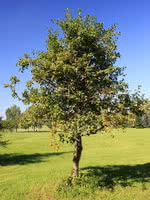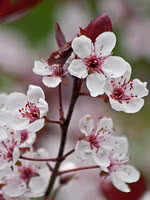Mon-Fri 9am - 5pm Mountain time
Washington Hawthorn vs Purple Leaf Sand Cherry
Crataegus phaenopyrum
Prunus x cistena
ONLY AVAILABLE BY CONTRACT GROW
ONLY AVAILABLE BY CONTRACT GROW
Washington Hawthorn is an attractive ornamental shrub that is dense enough to plant as a privacy screen. It produces clusters of white blooms in late spring to early summer.
Washington Hawthorn's red berries last throughout winter, bringing squirrels and birds to your property. In the fall, its foliage turns beautiful orange, scarlet, or purple.
One of the most overlooked trees on the prairies. This tree is often used as rootstock, a wildlife attractor, or a boulevard hedge. Give this one a second look.
This species is also known as one of the more salt-tolerant species for those with saline soils.
Please note: this plant is poisonous to dogs.
Purple Leaf Sand Cherry provides bright reddish-purple leaves that turn bronze-green in the fall. In the spring, tiny flowers with a pinkish white hue bloom. The flowers are small, but the impact comes from the shrub blossoming all at once.
The Purple leaf sand cherry can be susceptible to pests and diseases in more humid areas; a typical life span is approximately 15 years. Not suitable for a privacy hedge on its own but is often alternated with lilacs. Often used as an accent plant that attracts birds and bees.
Washington Hawthorn Quick Facts
Purple Leaf Sand Cherry Quick Facts
In row spacing: 0.9 m (3 ft)
Toxicity: the leaves and seed are slightly toxic

